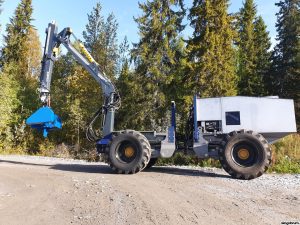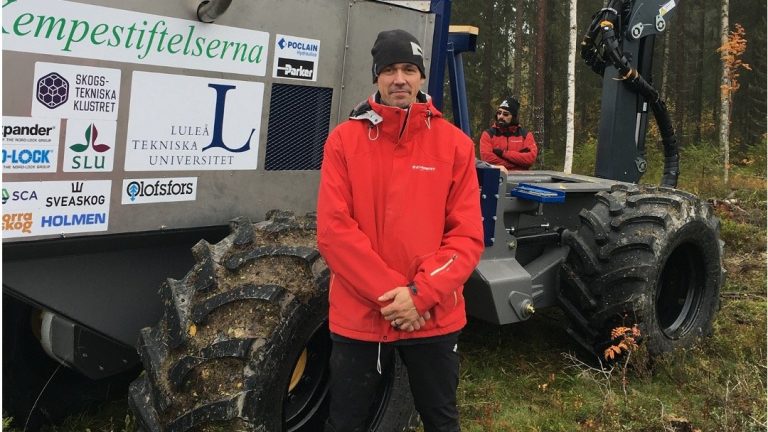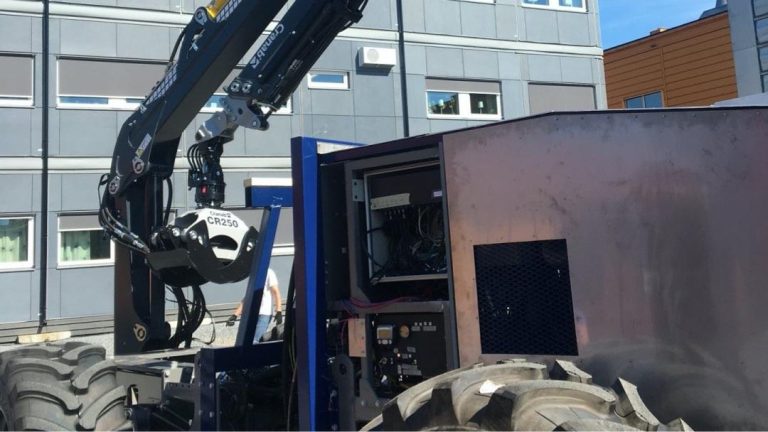The other day we wrote about that researchers at The Technical University of Luleå (LTU) are working on an autonomous (driverless) machine concept for forestry. A base unit has been manufactured as a platform for further development. The first to be tested with this platform is a scarifier.
The future is knocking on the door – a laboratory
The machine is part of a research project where several forestry companies are included. It´s important to point out that this is not a prototype. It is not a machine that we will see in the forest shortly. It is more to be compared to a laboratory, a base unit that will be used for different research projects within machine technology.
The project is called TFP (Terrain Vehicle Platform, the abbreviation is for the Swedish name)
The university, LTU, are specialists within this area. Their aim is to find new solutions within existing technologies in electronics and mechanics. The knowledge of forestry comes from the Swedish University of Agricultural Sciences, SLU, who are a part of the project. Also, researchers within robotics and algorithms are involved. Together they wish to contribute to the development of autonomous solutions. LTU are working with similar projects within construction machinery together with Volvo among others.
Photo: Klas-Håkan Ljungberg
Diesel engine and pendulum arms
The base unit weighs approx. 10 tons. It has a conventional driveline with diesel engine and hydrostatic transmission. The wheels are placed on pendulum arms, one on each arm. Furthermore, the machine is loaded with advanced technology such as sensors for measurements and steering.
Scarifying – a pilot project for the TFP
Researchers are looking to decrease the soil impact during scarifying for planting. At the same time, they want to keep the same number of planting spots as for traditional scarifying. Today, scarifying is made by the largest forwarders and skidders. They use a lot of energy to create the planting spots, and they scarify a lot more of the surface than what´s needed for the plants.
The idea is to create a gentler scarifying with the TFP, one that could be performed by a smaller, lighter and more or less autonomous machine. It seems that scarifying is a less complex area to automize than e.g. forwarding or harvesting, which makes it suitable to start with. The knowledge that comes out of this project could later be used when moving into more advanced applications.
Inverted scarifying
The machine on the photos has a type of scarifier for inverted scarifying mounted on it. This is not meant to be a commercial product. It´s part of the laboratory as a tool to measure and test how the soil could be prepared and how much energy it takes to do it.
During spring and summer 2021, the researchers at LTU will do field tests. The results of those will be presented during the autumn/winter 2021. One of the challenges is to make the machine recognize and avoid obstacles in the terrain, and to identify and find the best planting spots. Also planning and optimizing the working patterns is part of this. A drone will be involved to provide the machine with data.
Increased productivity with no operator
Thanks to the development of forestry machines, productivity has instantly increased over the years. Thanks to this, the costs for the forestry has decreased and the prices for forest products has been competitive. However, in the last few years, the increase in productivity has slowed down significantly. The development of forest machines has lately been all about making the machines more reliable and comfortable (and heavier).
The operators of the machines are necessary today, but they are also a limiting factor. They have working hours to consider, they get sick, etc. The ability to perform monotonous work is also a factor to count in, and the working environment is another important factor. Still, in the extremely complex environment the forest machines are operating in, we haven´t managed to replace the operators with sensors and computers – yet.
A machine with no operator could work 24/7 (theoretically). It would be cheaper to manufacture as there would be no need for a cabin or other working environment items. It would therefore also be lighter. So, cheaper and lighter machines mean more machines that means higher productivity.
Detection is the key
The big challenge when it comes to autonomous technology is detection. That is, to teach algorithms to, through photos and sensors, recognize items in the terrain, and react to them according in a pre-programmed way. It´s the same kind of challenge that the car industry has for autonomous cars – on plain asphalt.
How shall the machine see the difference between a rock and a stump? How shall it “read” the terrain … see the difference between different trees, etc.? Technicians, mathematicians and computer experts are working together to solve this.
Research on technology for forestry is far behind
It´s positive that a research project like this takes off. LTU are involved in a giant project within construction machinery. “Electric Site” is the name of the project where the Swedish Energy Agency, Volvo, Scania and others. Hundreds of millions of Swedish Krones are put into this single project. If the forestry business really wants to move in this direction, it will take broad collaborations with many parties to finance it.
According to LTU, the attitude to autonomous technology in the forest is changing. It´s moving from “useless science fiction” towards “this actually just might work…”. The interest of the authorities to financially support this kind of projects is also increasing.
Things have changed
50 years ago, the big forest companies bought the machines themselves. There were not so many contractors who owned the machines. Back then, the big companies would order machines that only existed on drawings, meaning they took a big risk, just to contribute to the development of forestry machines.
I recall a former Kockums salesman, who told the story from the early 70’s about how they invited a “big boss” at a major forest company to show the latest prototype of a harvester/processor. The man watched the machine working without saying a word. When he had seen what he wanted to see, he walked back to his car. Just as he opened the car door, he turned around and said: “We order 15 of those and then we will see.” Does that happen today?
Small contractors own the machines
Since a few decades back, the machines are owned by small companies, contractors, that have no possibility to take such risks. This logically affects technical development in the forest. The progress that is made today is mainly about finetuning the machine systems that already exist to make them more efficient.
If Sweden and Finland want to keep the leading position in forestry equipment, they will for sure need more research and development like what´s now happening at LTU. It´s positive to see that large forest companies like Holmen, SCA and Sveaskog, and machine manufacturer Komatsu Forest, are active in a number of projects for the technical development of forest machines.
What about the people working in the forest?
Every time the subject “machines to replace people” comes up, there are always reactions like “the machines will take our jobs …”. Well, it may be true, but as one of the major problems for the forestry business is to convince young people to start working as machine operators in the forest, the development described here above should be seen as positive. The average age among the operators is quite high.
Us older dudes like me remember when the harvesters came and kicked the chainsaw workers out of the forest. We had the same discussion back then. When it comes down to it, it´s all about two things: Are people going to want products from the forest, like paper, wood, bioenergy, etc.? And; Do we want to be competitive compared to other materials?
Reality can be hard. Unfortunately, I think this a reality we have to live with if we want to keep the forestry business alive.














